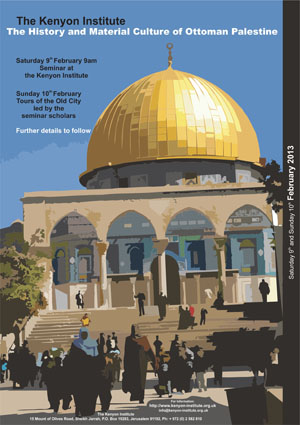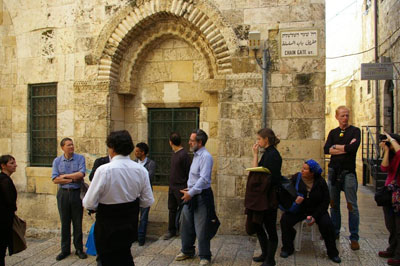
A SEMINAR ON THE HISTORY AND MATERIAL CULTURE OF OTTOMAN PALESTINE AT THE KENYON INSTITUTE, JERUSALEM
By Micaela Sinibaldi, Cardiff University, UK
On the 9th and 10th of February 2013 I had the great pleasure of organizing a seminar entitled: The History and Material Culture of Ottoman Palestine at the Kenyon Institute in Jerusalem. The seminar consisted of a day of papers and a roundtable discussion at the Kenyon and a day of tours of the Old City led by some of the seminar scholars.
As an archaeologist who works on the Islamic period, I know from my fieldwork and research, which has been especially focused on Petra (Jordan), that it is particularly the later periods which are still largely unexplored by archaeology, particularly the Ottoman period. During my recent work for Brown University, for example, as a co-director of excavations at Islamic Bayda (Petra region), a village whose occupation spans the whole Islamic period, it appeared from my preliminary research that the latest and most extensive phase is Ottoman; however, almost no material is currently available in the region for providing the excavation results with some archaeological parallels. One of the reasons for a very recent interest in the archaeology of the Ottoman period is that, partly because of the wealth of both documentary and monumental architectural sources available, the study of material culture has naturally focused on buildings such as the impressive ones preserved in Jerusalem in the al-Haram al-Sharif and in other areas of the Old City of Jerusalem, rather than on rural sites or on the use of archaeology to help solve chronological questions. The study of monumental architecture has often been supported by documentary sources allowing the reconstruction of its history in detail. I therefore started developing an interest in organizing a meeting of specialists of the Ottoman period to discuss how their work makes use of the different kinds of sources and to hear their perspectives on future research in this field, which still holds much potential for many years to come.

I was fortunate to be able to spend two days with distinguished scholars expert of the history, architecture and archaeology of the Ottoman period of Jerusalem and Palestine, to discuss with them these important topics, and learn to about their recent research. Dr. Yusuf Natsheh, the Director of the Department of Tourism and Archaeology at al-Haram al-Sharif in Jerusalem, presented a paper on Architectural Stylistic Trends of Ottoman Jerusalem, the subject of his well-known research contributing to the volume Ottoman Jerusalem: The Living City: 1517-1917 (edited by S. Auld and R. Hillenbrand, 2000). Mohammad Ghosheh, an independent scholar and currently Fellow at the Albright Institute in Jerusalem, talked about The Haram al-Sharif under the Ottomans, presenting to the audience illustrations from his recently published monograph (Qubbat al-Sakhrah al-Musharrifah, 2012, whose English language edition, The Dome of the Rock, will be published in 2013). Khader Salameh, until January 2013 the Director of al-Aqsa Mosque Library and of the Islamic Museum in al-Haram al-Sharif, offered his recent research results on The Restorations of Sultan Mahmoud II in Jerusalem, object of his forthcoming publication. Dr. Robert Schick, an independent scholar well known for his wide experience of Jerusalem where he has lived and researched for many years, gave for the first time in Jerusalem the lecture Everyday Life in the Masjid al-Aqsa Compound in the Ottoman Period, which focused on the analysis of a selection of documentary sources showing some practical aspects of running the compound. Two more speakers also presented their research for the first time at this seminar: Dr. Mahmoud Hawari, research associate at the University of Oxford whose best known work is the book Ayyubid Jerusalem (1187-1250), illustrated his research in progress for his forthcoming monograph on the Citadel of Jerusalem: The Citadel (Qal’a) of Jerusalem in the Ottoman Period: An Overview, and Susynne McElrone, an advanced Ph.D student at New York University, presented the subject of her thesis research with the paper Hebron in the Long Nineteenth Century: the Historiography and the History.
The roundtable discussion focused on the use of sources for the study of the Ottoman period and stimulated important research topics, such as the need for more collaboration between historians, art historians, and archaeologists; the desire for future research to focus more on rural architecture rather than be limited to the better known monumental architecture and on the peripheral areas to integrate with research on urban centres; and the issue of access to archival sources and how to solve them.
The seminar day was a success with over fifty participants, and the roundtable and panel discussions saw the active participation of the audience, which included scholars from different institutions and individuals from the Jerusalem community. Moreover, much appreciated and important for our discussion was the presence of scholars and participants from the seminar Recent Advances in Islamic Archaeology, organized under the auspices of the Albright Institute the previous day. On the seminar day, we had an excellent Maghloube lunch in the Kenyon garden, kindly offered by Dr. Mandy Turner.

It was a great pleasure to receive emails from the audience commenting on how much they enjoyed the whole event and to know that the speakers found this a very welcome opportunity for research discussion and further collaborations with each other.
I am grateful to Dr. Mandy Turner, Director of the Kenyon Institute, for hosting, supporting, and funding the event and for all her precious suggestions; the speakers for making the event such a success by accepting my invitation, by generously discussing with me aspects of the organization and by being so flexible with all my requests; and finally, the audience for their welcome presence and active participation in the discussions, which really made the event a collaborative effort.